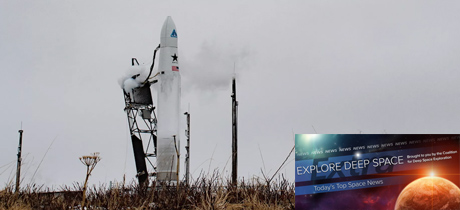In Today’s Deep Space Extra… NASA seeks new astronaut applicants. The European and Russian space agencies press to overcome technical issues with parachutes in order to make a July/August launch window for their Exo/Mars lander and rover. Visionaries hold on to belief a more hospitable Mars is possible.
Human Space Exploration
Want to go to the Moon? NASA is now taking new astronaut applications
Space.com (3/2): On Monday, NASA began accepting applications for a new class of astronauts. The online application process for qualified U.S. citizens extends through March 31. Final selections for a new class of astronauts whose size has not yet been determined is expected in mid-2021.Their destination could include the Moon and Mars as well as the International Space Station (ISS) or an Earth orbiting commercial successor.
How Christina Koch could become a spaceflight legend
The Atlantic (3/2): NASA astronaut Christina Koch recently returned to Earth following a spacewalk punctuated, 328 day mission to the International Space Station (ISS), the longest space flight ever by a woman. NASA’s tackling an accelerated human return to the surface of the Moon in 2024, a step in an effort to move on to Mars in the decade that follows. Koch may have set the stage for a century of new milestones in space exploration, the kind that can turn space faring humans into celebrities.
Terraforming Mars might be impossible for now
Cnet.com (3/2): A popular notion of making neighboring Mars more hospitable to humans through terraforming the now cold, dry landscape and environment, with nuclear explosions or assembling giant mirrors in orbit to focus sunlight on the surface appears increasingly unlikely. Some visionaries, however, believe favorable changes could be engineered in the future with more sophisticated technologies.
Space Science
ExoMars parachute tests delayed, mission faces review
SpaceNews.com (3/2): Plans to proceed with the joint European and Russian space agencies ExoMars 2020 lander and rover mission to Mars await the outcome of parachute tests now delayed until late March. The July 25 to August 13 Mars launch window for ExoMars is at stake based on the outcome. The mission has struggled with the parachute performance necessary to slow for a landing on the red planet early next year, and has turned to NASA for assistance. The heads of the European and Russian space agencies are to confer March 12 on the next steps.
NASA approves development of universe-studying, planet-finding mission
NASA Goddard Space Flight Center (3/2): Though targeted for cancellation in NASA’s proposed 2021 budget, the Wide Field Infrared Space Telescope (WFIRST), a companion to the James Webb Space Telescope (JWST), has cleared a critical programmatic and technical milestone required for further development, NASA announced on Monday. Its missions include studies of dark energy and extra solar planets. Next up, the assembly of engineering test units and models to ensure the design will hold up under the extreme conditions during launch and while in space. The cost of development and five years of operations is estimated at just under $4 billion. Work is funded through September 30. If cancelled, work on WFIRST could be suspended until the launch of JWST, anticipated for 2021.
Meet LUVOIR, which might become one of NASA’s next big space telescopes
Space.com (3/2): The Large UV/Optical/IR Surveyor, or LUVOIR, is a candidate for a future NASA space telescope that would attempt to address a range of scientific topics, including extra solar planets perhaps similar to the Earth. Concept assessments are underway.
Op Eds
Space is our new economic frontier. The U.S. cannot afford to lose out
CNN (3/2): U.S. Chamber of Commerce president Suzanne Clark offers an endorsement of the administration’s proposed $25.2 billion budget for NASA in 2021, a 12 percent increase to back a vigorous effort to explore space. The push is sure to help grow a vital space economy, one projected by chamber economics to reach $1.5 trillion by 2040, according to Clark. “While no one can fully grasp what our economy will look like 20 years from now, one thing is certain: the private sector space industry will transform how societies across the globe live, communicate and do business. In fact, it already has,” notes Clark.
Other News
Chinese billionaire starts satellite venture to rival Musk’s SpaceX
Bloomberg (3/3): Chinese automaker Geely has announced plans to establish a satellite network to support what it terms a “three dimensional mobility ecosystem.” “The goal is a low altitude network of small satellites to support high-speed data transmission for precise navigation and cloud computing. The move is to enable rapid updates to its vehicle brands and delivery of content to the company’s owners, whose assets include Volvo and Lotus Cars.
U.S. Space Force budget projected to grow $2.6 billion over the next five years
SpaceNews.com (3/2): The 2020 National Defense Authorization Act requires the Air Force to provide an estimate of the cost to standup the Space Force, which was established on December 20. As part of the Administration’s 2021 budget request, the Air Force is to shift $15.4 billion to the Space Force. An additional $2.6 billion will be needed over the next five years, according to a report provided Congress by Air Force Secretary Barbara Barrett.
DARPA launch challenge ends with no winner
Axios (3/2): Unable to launch from Alaska on Monday due to a technical issue, California based Astra lost an opportunity to win a $2 million prize offered by the Defense Advanced Research Program Agency’s (DARPA) launch challenge and possibly another $10 million with another launch this month. DARPA initiated the challenge to determine the difficulties faced by private companies in launching twice from two locations with little notice from military customers.

